I always like to share this day in photos and information. I have shared this same post before, but I've added a few notes this year, along with a few new images. It seems since I copied the bones of this post from 2019, the post has reverted back to 2019 and the comments, too.
Although the majority of my readers were not born when the attack on Pearl Harbor occurred, this is the day the worst attack on American soil occurred prior to 9/11. A total of 2,403 Americans died and 1,178 were wounded. Even though this is an American event, it affected the majority of the world. I am sharing this again because I couldn't find anything better than this post I created four years ago. Since many are new to my blog, I thought it was appropriate to share it again.
As I've stated before, this is a LONG diatribe and, unlike how I normally share information, I offer very few references, because most of this information is my own that I learned as an undergrad, from books I've read, or documentaries I've seen on WWII. All opinions are my own. All photos are from Wikipedia, unless otherwise specified.
The events leading up to the attack on Pearl Harbor can be traced back to 1852, while Japan was still an isolationist country. Until that time, trade with the west was strictly limited to the Dutch trading in Nagasaki. Since Westerners weren't allowed in the country, their influence was strongly discouraged.
.png/800px-Gasshukoku_suishi_teitoku_k%C5%8Dj%C5%8Dgaki_(Oral_statement_by_the_American_Navy_admiral).png) In July, 1853, Commander Matthew C. Perry, sent by the U.S. to forcibly
establish trade with Japan, initially faced resistance.
In July, 1853, Commander Matthew C. Perry, sent by the U.S. to forcibly
establish trade with Japan, initially faced resistance. It didn't take
Perry long to overpower the Japanese, though.
It didn't take
Perry long to overpower the Japanese, though.  According to Asia for Educators:
According to Asia for Educators:Upon seeing Perry's fleet sailing into their harbor, the Japanese called them the "black ships of evil mien (appearance)." Many leaders wanted the foreigners expelled from the country, but in 1854 a treaty was signed between the United States and Japan which allowed trade at two ports.
 Further according to Asia for Educators:
Further according to Asia for Educators: In 1858 another treaty was signed which opened more ports and designated cities in which foreigners could reside. The trade brought much foreign currency into Japan disrupting the Japanese monetary system. Because the ruling shôgun seemed unable to do anything about the problems brought by the foreign trade, some samurai leaders began to demand a change in leadership.
It didn't take the Japanese long to begin their reformation. They started by ousting the shogun, who was the ruler at the time, and placed the emperor back in control. According to World History.org:
Then, after years of ineffectual government and failure to meet the threat of foreign powers like Great Britain and the United States, the Meiji Restoration finally abolished the position of shogun and restored full powers to the emperors.
They watched how the west had colonized many countries, and began their
own colonization process. This led to their need for new materials and
goods, which were in short supply in Japan. Not only did they begin
imitating the West, they began dressing like them, too.
By trying to imitate a 19th century European power, they had to engage
in imperialism. The obvious target for imperialism was Korea. The problem was that the Korean
king paid tribute (monetary contributions similar to taxes) to the Chinese emperor. While the Japanese could, and
did force the Koreans to sign some unequal treaties, the peninsula
remained free of the Japanese.
However, in 1894, China sent troops into Korea to help put down a rebellion, violating a previous treaty, so the Japanese also sent in troops. Fighting broke out which lead to the First Sino-Japanese War in 1894 and 1895. According to Dokdo Takashima:
The Western method of opening Japan to commerce was to threaten war against the Tokugawa Shogunate (1603-1868) should it refuse to sign trade treaties. Essentially these treaties were unequal contracts signed under duress- the explicit or implicit threat of force which gave the British and other Western powers rights and privileges that went unreciprocated.
Further:
Documented plans for a Japanese invasion of Korea via Ganghwando date back to at least the year 1869.
Then the Japanese attacked a group of Koreans on Korean soil. According to Dokdo Takashima:
The well armed Japanese army quickly annihilated the Koreans who were poorly equipped with muskets (35 were killed).
While the Japanese asserted the Korean attack was unexpected, certain facts about the incident show us the Un-yo’s landing was a deliberate attempt to provoke the Koreans into a military confrontation. This would in turn, give the Japanese “justification” for attacking Korea.
Further:
War between China and Japan was officially declared on August 1st 1894 and the Imperial Japanese defeated the poorly armed Beiyang Army in the Battle of Pyeongyang on September 16th and quickly pushed North into Manchuria. The Imperial Japanese Navy destroyed 8 of the 12 warships of the Chinese Beiyang Fleet off the mouth of the Yalu River on September 17th 1894. The Chinese fleet subsequently retreated behind the Weihwai fortifications. However, they were then surprised by Japanese ground forces, who outflanked the harbor’s defenses.
The Chinese lost the war, and lost it badly. After that, Korea stopped paying tribute to China and soon became a Japanese tributary state. Japan also took over Taiwan, which led to the rivalry with Russia over Manchuria. Again, according to Dokdo Takashima:
Throughout the 1880s and 1890s important events transpired that would shape Japan’s foreign policy toward Korea. In 1882 the Chulmupo Treaty would be signed by Korea and this would prove significant a years later . During the spring of 1894 there was an uprising by a rebel group known as the Tonghaks. As Chinese forces advanced toward Korea, the Japanese army general staff mobilized the Fifth Division and requisitioned several transports.
By trying to imitate a 19th century European power, they had to engage
in imperialism. The obvious target for imperialism was Korea. The problem was that the Korean
king paid tribute (monetary contributions similar to taxes) to the Chinese emperor. While the Japanese could, and
did force the Koreans to sign some unequal treaties, the peninsula
remained free of the Japanese.
 By trying to imitate a 19th century European power, they had to engage
in imperialism. The obvious target for imperialism was Korea. The
problem was that the Korean
king paid tribute (monetary contributions similar to taxes) to the
Chinese emperor. Long before there was a North and South Korea, it was a unified country. Both China and Russia had their eye on Korea and each wanted to control it. That is, until Japan got in the way.
By trying to imitate a 19th century European power, they had to engage
in imperialism. The obvious target for imperialism was Korea. The
problem was that the Korean
king paid tribute (monetary contributions similar to taxes) to the
Chinese emperor. Long before there was a North and South Korea, it was a unified country. Both China and Russia had their eye on Korea and each wanted to control it. That is, until Japan got in the way.
By the late 1900s, Japan was still subject to racism from Western world powers such as Britain
and France. Imperial expansion was Japan's last chance to gain any
respect, power, and immigration in the harsh world. Korea was the
perfect place to start. Unfortunately for Japan, China and Russia also
had their eyes on Korea, and it was a constant battle between the
three countries. Finally, Japan was happy with the land they had won through war, and
began their imperialism on the Korean people.
While the Japanese could, and
did force the Koreans to sign some unequal treaties, the peninsula
remained free of the Japanese.
 However, in 1894, China sent troops
into Korea to help put down a
rebellion, violating a previous treaty, so the Japanese also sent in
troops. Fighting broke out which lead to the First Sino-Japanese War in
1894 and 1895.
However, in 1894, China sent troops
into Korea to help put down a
rebellion, violating a previous treaty, so the Japanese also sent in
troops. Fighting broke out which lead to the First Sino-Japanese War in
1894 and 1895.
The Chinese lost the war, and lost it badly. After that, Korea stopped paying tribute to China and soon
became a Japanese tributary state. Japan also took over Taiwan, which led to the rivalry with Russia over Manchuria.
 From there, the rivalry escalated to the Russo-Japanese War which lasted
18 months in 1904 and 1905. Japan emerged the winner and was now
looked on as a world leader. Manchuria was taken over, as was Korea,
since the Russians were in no position to maintain control.
From there, the rivalry escalated to the Russo-Japanese War which lasted
18 months in 1904 and 1905. Japan emerged the winner and was now
looked on as a world leader. Manchuria was taken over, as was Korea,
since the Russians were in no position to maintain control.
This set up the fate of Korea which in my estimation was clearly and undeniably sadistic. The atrocities imposed on the Koreans was so sadistic, I won't go into them here. Some of the things the Japanese did were so cruel, they turned my stomach. And I'm not easily swayed by words and images. However, one story you might want to read can be found at this link at History.com.
 During WWI, Japan joined the Allies, where they took out Germany's colonial empire in the Pacific Ocean.
During WWI, Japan joined the Allies, where they took out Germany's colonial empire in the Pacific Ocean.
 This included New Guinea, Micronesia, the Marshall Islands, and Samoa.
This was probably when Japan was the most powerful and largely accepted
by
Western powers. It was obvious Japan had acted exactly as the various
European colonial powers had.
This included New Guinea, Micronesia, the Marshall Islands, and Samoa.
This was probably when Japan was the most powerful and largely accepted
by
Western powers. It was obvious Japan had acted exactly as the various
European colonial powers had.
However, according to Quotesgram.com:
during the period of peace between the two world wars, aggressively expansionist moves, though far from unheard of, were frowned on by many nations. It wasn't simply a matter of geopolitics, either. Most people in Europe really did not want another war, and the countries that seemed to be provoking those wars were looked upon unfavorably. Because Japan hadn't suffered in WWI the way countries like France, Great Britain, and Belgium had, they were looked upon as warmongers, or part of a group who wanted to bring the world once again to the brink of war.
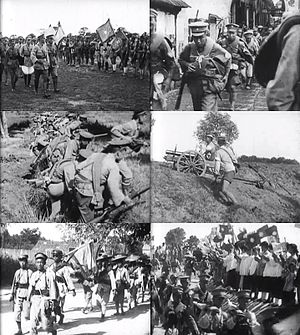 Also during this time, China began to get organized. First the south
was unified under its government, then the military campaign, led by
Also during this time, China began to get organized. First the south
was unified under its government, then the military campaign, led by Chiang Kai-shek from 1926 to 1928 by what is now called the Northern
Expedition, aided by Soviet arms, unified China by ending the rule of
the the local warlords along the Yangtze River.By 1930, Chiang had unified China under what was certainly the most
enlightened government in its history. China was moving toward Chiang’s
ultimate goal of a constitution, creating a republic, with free
elections.
Chiang Kai-shek from 1926 to 1928 by what is now called the Northern
Expedition, aided by Soviet arms, unified China by ending the rule of
the the local warlords along the Yangtze River.By 1930, Chiang had unified China under what was certainly the most
enlightened government in its history. China was moving toward Chiang’s
ultimate goal of a constitution, creating a republic, with free
elections. Japan viewed China's reunification as a threat to its control of
Manchuria's railroads. Losing anything to China was seen as
unacceptable, so in 1931, the Japanese invaded Manchuria to protect
their interests in the railroad. Japan subsequently set up a puppet
state which nobody else
recognized as a legitimate state. This isolated Japan, and it also
meant
a continuing series of border clashes with the Chinese. At the same time, the communists established their own base in
remote northwest China. For the next several years, Chiang was forced to
fight a two-front war inside his own country, both against the Japanese and
against the communists determined to overthrow the new government and
establish a communist dictatorship.
Japan viewed China's reunification as a threat to its control of
Manchuria's railroads. Losing anything to China was seen as
unacceptable, so in 1931, the Japanese invaded Manchuria to protect
their interests in the railroad. Japan subsequently set up a puppet
state which nobody else
recognized as a legitimate state. This isolated Japan, and it also
meant
a continuing series of border clashes with the Chinese. At the same time, the communists established their own base in
remote northwest China. For the next several years, Chiang was forced to
fight a two-front war inside his own country, both against the Japanese and
against the communists determined to overthrow the new government and
establish a communist dictatorship. In 1937, the Japanese took Shanghai and Nanking, forcing Chiang’s
government inland. With Chiang preoccupied fighting the
foreign invaders, the communists took the opportunity to expand their
own territorial holdings. For the next several years, Chiang stood alone
against the Japanese aggressors. It was at this time the Japanese provoked the Chinese into a full-scale war, known as the Second Sino-Japanese War, or the Eight Year War.
In 1937, the Japanese took Shanghai and Nanking, forcing Chiang’s
government inland. With Chiang preoccupied fighting the
foreign invaders, the communists took the opportunity to expand their
own territorial holdings. For the next several years, Chiang stood alone
against the Japanese aggressors. It was at this time the Japanese provoked the Chinese into a full-scale war, known as the Second Sino-Japanese War, or the Eight Year War. This was a bloody war, with many photos too gruesome to show on my
blog. However, this is a photo of Japanese soldiers with gas masks and
rubber gloves on during the Battle of Shanghai. More details:
This was a bloody war, with many photos too gruesome to show on my
blog. However, this is a photo of Japanese soldiers with gas masks and
rubber gloves on during the Battle of Shanghai. More details:The Second Sino-Japanese War (July 7, 1937 – September 9, 1945) was a military conflict fought between the Republic of China and the Empire of Japan. From 1937 to 1941, China fought Japan with some economic help from Nazi Germany (until 1938), the Soviet Union (1937-1940) and the United States (see American Volunteer Group). After the Japanese attack on Pearl Harbor, the war merged into the greater conflict of World War II as a major front in the Pacific Theatre. The Second Sino-Japanese War was the largest Asian war in the twentieth century. It also made up more than 50% of the casualties in the Pacific War.
Although the two countries had fought intermittently since 1931, full-scale war started in earnest in 1937 and ended only with the surrender of Japan in 1945. The war was the result of a decades-long Japanese imperialist policy aiming to dominate China politically and militarily, and to secure its vast raw material reserves and other economic resources, particularly food and labor. At the same time, the rising tide of Chinese nationalism and notions of self-determination stoked the coals of war. Before 1937, China and Japan fought in small, localized engagements, so-called "incidents". Yet the two sides, for a variety of reasons, refrained from fighting a total war. In 1931, the Japanese invasion of Manchuria by Imperial Japan's Kwantung Army followed the "Mukden Incident". The last of these incidents was the Marco Polo Bridge Incident of 1937, marking the beginning of full scale war between the two countries.
Had the Second Sino-Japanese War been a short one, the Japanese might
have walked away with a hugely favorable treaty and land cessions similar to the First Sino-Japanese War.
However, the
Nationalist government didn't give in, so this took many more resources
than Japan had at the time. In my opinion, this was the beginning of
Japan's decision to bomb Pearl Harbor, since this war pushed the
Japanese economy and the military to the breaking point.
Japan's supplies of rubber, iron, and oil were pushed to the breaking
point, who now had no allies in the region. The
view in the international community was that Japan was a rogue state, which
did not help Japan procure the materials needed to keep fighting the
war in China. An attack on a U.S. gunboat on the Yangtze River alienated
the U.S., as did widespread Japanese atrocities against Chinese
civilians. Eventually, this led to embargoes on trade with
Japan.
At this point, Japan was in peril. It had assembled a colonial empire
both to enable Western-style industrialization and to establish
credibility as a great power. Yet, because World War I hadn't
affected Japan in the same way it had Europe, Japan's
continued warmongering actions now alienated both the U.S. and Europe.
I remember the gist of a quote from a book I read on WWII was that the
West taught Japan poker, but after Japan won all the chips, declared
the game immoral.
And while it's true that the Western powers hadn't
perpetrated anything along the lines of the Rape of Nanking, the bloody
battle that involved persecution, looting, and rape when Japan took the
capitol city of China, the West was not blameless in some of their
actions, either.
Since Japan desperately needed resources, there were only two places to
get them. One place was Siberia and the other was the South Pacific.
The Imperial Army favored invading Siberia, while the Imperial Navy
wanted to take the South Pacific.
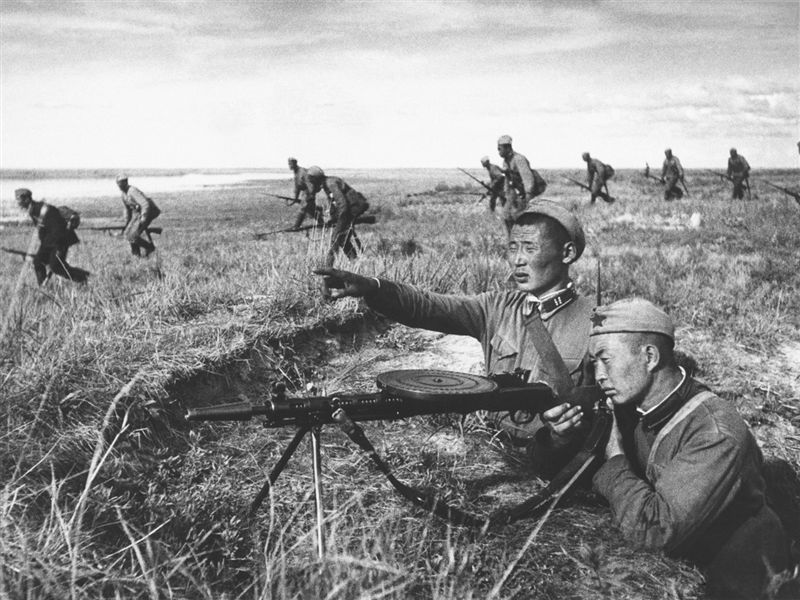 The Imperial Army was forced to abandon their quest for Siberia when in
August, 1939, just weeks before Hitler and Stalin invaded
Poland, the Soviet Union and Japan fought a massive tank battle on the
Mongolian border. The Soviets won a crushing victory, the largest the
world had ever seen to date. Defeat persuaded the Japanese to expand
into the Pacific, where they saw
the United States as a weaker opponent than the Soviet Union. And
although this is just conjecture on my part, if the
Japanese had not lost this battle, they might never have attacked
Pearl Harbor.
The Imperial Army was forced to abandon their quest for Siberia when in
August, 1939, just weeks before Hitler and Stalin invaded
Poland, the Soviet Union and Japan fought a massive tank battle on the
Mongolian border. The Soviets won a crushing victory, the largest the
world had ever seen to date. Defeat persuaded the Japanese to expand
into the Pacific, where they saw
the United States as a weaker opponent than the Soviet Union. And
although this is just conjecture on my part, if the
Japanese had not lost this battle, they might never have attacked
Pearl Harbor.
It was a decisive victory for the Soviets in other ways, too. When the
Japanese decided to expand in the south, it also meant that the Soviets
didn't have to fight on two fronts, but could use their troops against
the threat of Nazi Germany in
the West. In terms of its strategic impact, this battle and subsequent
Soviet victory was one of the most decisive battles of the Second World
War. It also served to show the Japanese military that it was not a
match for the Soviets, especially since Japanese forces were still
fighting throughout China. The
Soviets forces were stunning, while
Japanese tactics remained stuck in the traditional mindset that more
highly valued
honor and personal bravery on the battlefield than massive
forces.
After defeating the warlords, the Nationalist army turned on Britain,
who became their primary enemy.
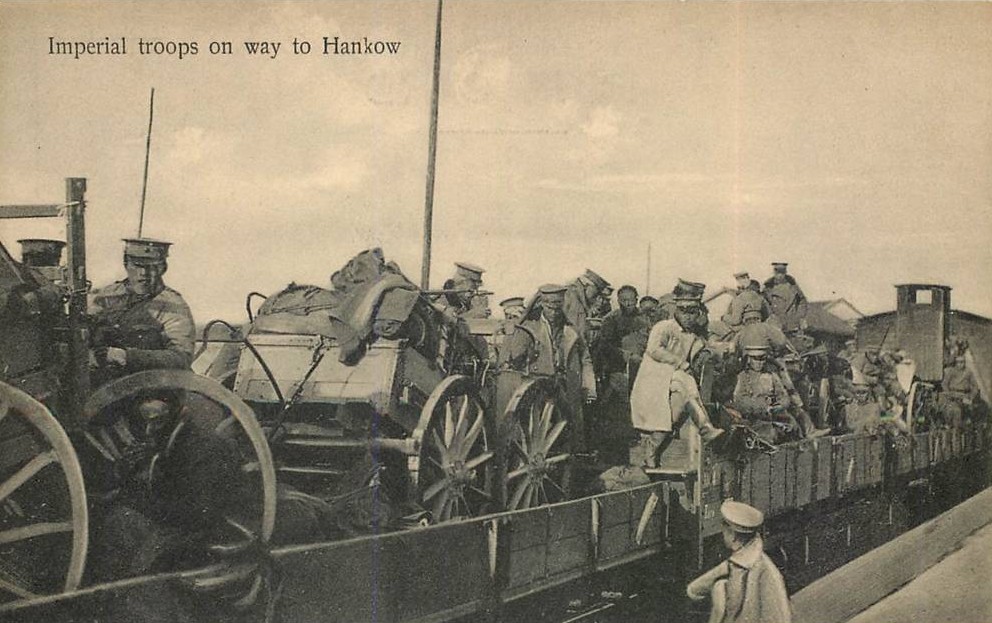 In response, the British
retaliated in Hankou and Jiujiang but prepared to defend
Shanghai. It was at that point the alliance between the communists and
the Nationalists fell
apart.
In response, the British
retaliated in Hankou and Jiujiang but prepared to defend
Shanghai. It was at that point the alliance between the communists and
the Nationalists fell
apart.
 After Pearl Harbor, Chiang announced to President Franklin Roosevelt,
“To our new common battle, we offer all we are and all we have, to stand
with you.” China's efforts during WWII cannot be overlooked. Chiang kept Japanese soldiers tied down on the Chinese mainland which kept them from fighting the Americans and British.
After Pearl Harbor, Chiang announced to President Franklin Roosevelt,
“To our new common battle, we offer all we are and all we have, to stand
with you.” China's efforts during WWII cannot be overlooked. Chiang kept Japanese soldiers tied down on the Chinese mainland which kept them from fighting the Americans and British.
 The end result to all this was the Imperial Japanese Navy got its way,
although it had to deal with the fact that
the South Pacific had already been colonized. As a result, there were
simultaneous
attacks on Pearl Harbor, Singapore, Hong Kong, the Philippines, and
Malaya. The Japanese felt the United States was a less formidable
adversary and didn't want war with the U.S. or the British while they
scrambled for rubber and oil. This turned out to be suicidal
and a complete misreading of how the Americans would react to Pearl
Harbor, but it was, as I see it, about 90 years in the making. The
above photo shows what Pearl Harbor looked like in October, 1941.
The end result to all this was the Imperial Japanese Navy got its way,
although it had to deal with the fact that
the South Pacific had already been colonized. As a result, there were
simultaneous
attacks on Pearl Harbor, Singapore, Hong Kong, the Philippines, and
Malaya. The Japanese felt the United States was a less formidable
adversary and didn't want war with the U.S. or the British while they
scrambled for rubber and oil. This turned out to be suicidal
and a complete misreading of how the Americans would react to Pearl
Harbor, but it was, as I see it, about 90 years in the making. The
above photo shows what Pearl Harbor looked like in October, 1941.
_burning_after_the_Japanese_attack_on_Pearl_Harbor_-_NARA_195617_-_Edit.jpg/800px-The_USS_Arizona_(BB-39)_burning_after_the_Japanese_attack_on_Pearl_Harbor_-_NARA_195617_-_Edit.jpg) Even though Pearl Harbor was a defeat for U.S. troops and the Pacific
Fleet, the Japanese didn't learn the lessons handed them by the
Soviets. Honor and bravery remained central to the Japanese military
mentality
and, once they had recovered from the initial onslaught, the U.
S. and Britain were able to combine forces and push the Japanese
out of the Pacific and back to Japan in one brutal battle
after another.
Even though Pearl Harbor was a defeat for U.S. troops and the Pacific
Fleet, the Japanese didn't learn the lessons handed them by the
Soviets. Honor and bravery remained central to the Japanese military
mentality
and, once they had recovered from the initial onslaught, the U.
S. and Britain were able to combine forces and push the Japanese
out of the Pacific and back to Japan in one brutal battle
after another.
This leads to another point I personally saw that still existed, albeit
far less, when I worked with Japanese in industry. The Japanese
believed that America, as a nation of diverse races of peoples, was
a mongoloid mix incapable of acting with a united resolve. That
perception was fueled by the propaganda perpetrated by Japan that they
were the superior race.
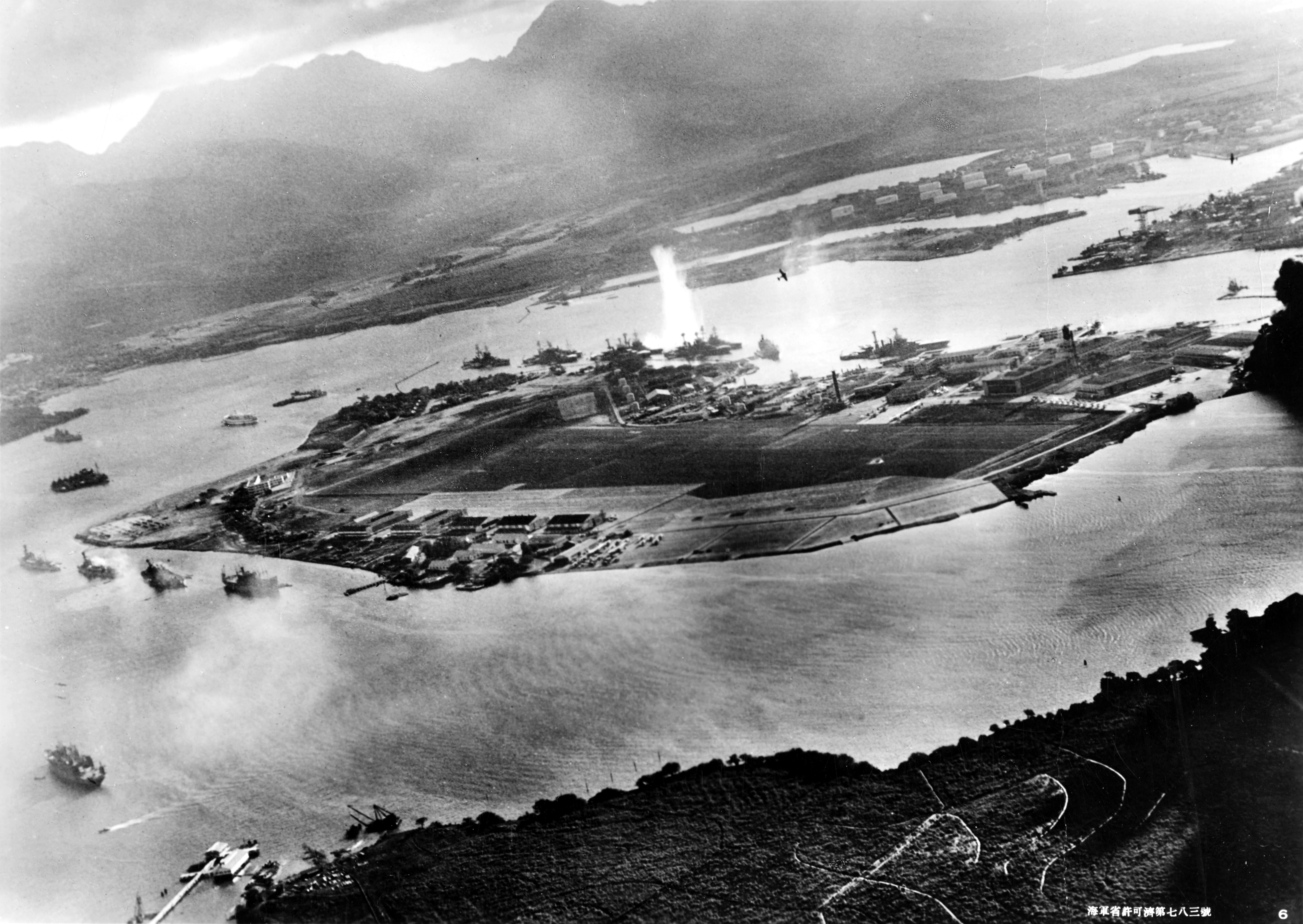 America was quite alien to the Japanese, and
it's not surprising that the homogeneous Japanese couldn't
comprehend how such a diverse range of extreme individuals, an attribute
prized by Americans, could possibly become a united and unified body.
America was quite alien to the Japanese, and
it's not surprising that the homogeneous Japanese couldn't
comprehend how such a diverse range of extreme individuals, an attribute
prized by Americans, could possibly become a united and unified body.
The Japanese Imperial Navy convinced themselves and their country that a
devastating attack would dishearten the Americans who would come to
accept a new reality of Japanese superiority. This photo shows how the
Japanese saw Pearl Harbor right before the first bombing attack.
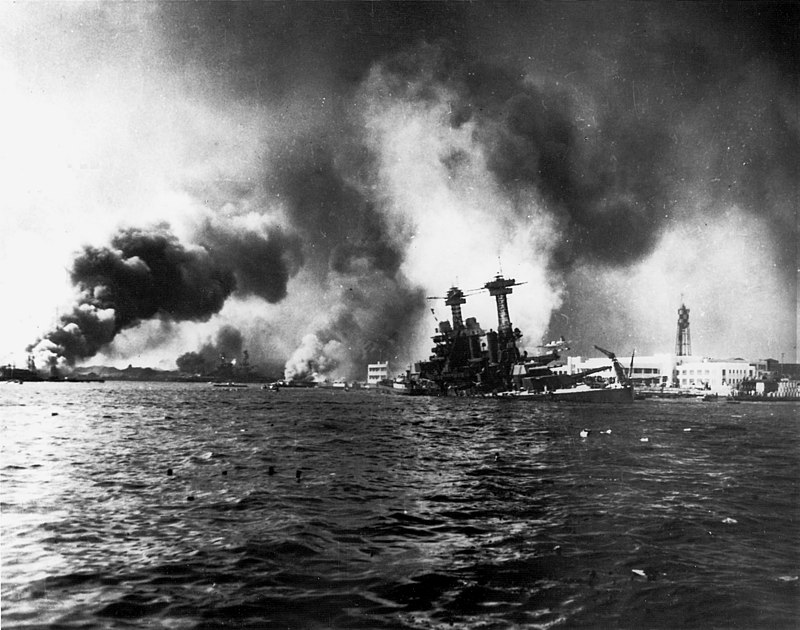 Beside the fact the Japanese wanted the oil, rubber, food, and wealth
they thought they could gain by conquering the U.S. through economic
attrition, they also
hoped they could wear the U.S. down politically, which would enable them
to keep
their conquests.
Beside the fact the Japanese wanted the oil, rubber, food, and wealth
they thought they could gain by conquering the U.S. through economic
attrition, they also
hoped they could wear the U.S. down politically, which would enable them
to keep
their conquests.
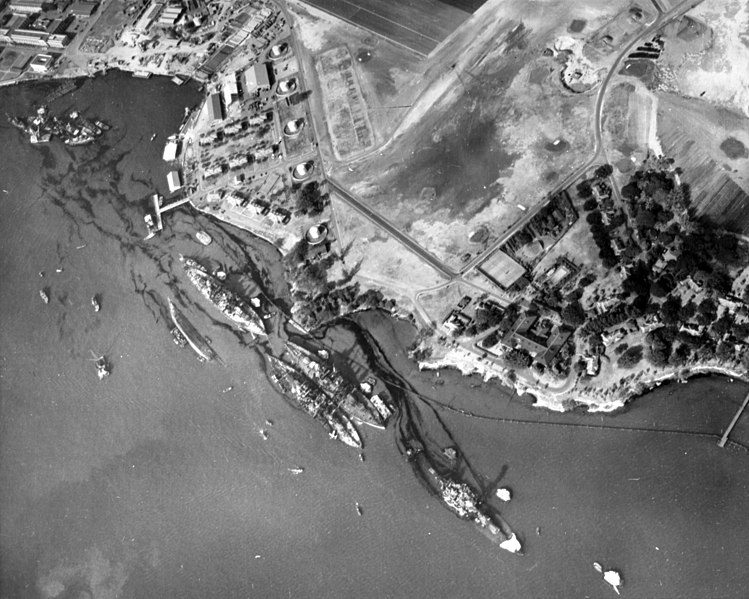 Not everything went according to plan, though. According to Wikipedia:
Not everything went according to plan, though. According to Wikipedia:
Important base installations such as the power station, shipyard, maintenance, and fuel and torpedo storage facilities, as well as the submarine piers and headquarters building (also home of the intelligence section) were not attacked.Although the Japanese dealt a huge blow that December 7, 1941, it didn't take the U.S. long to regain control. This was especially true since, also according to Wikipedia:
Within six months, five battleships and two cruisers were patched or refloated so they could be sent to shipyards in Pearl Harbor and on the mainland for extensive repair.Further, to our (U.S.) shame, according to the same Wikipedia article:
One further consequence of the attack on Pearl Harbor and its aftermath was that Japanese American residents and citizens were relocated to nearby Japanese-American internment camps. Within hours of the attack, hundreds of Japanese American leaders were rounded up and brought to high-security camps such as Sand Island.And finally, also according to Wikipedia:
Fortunately for the United States, the American aircraft carriers were untouched by the Japanese attack; otherwise the Pacific Fleet's ability to conduct offensive operations would have been crippled for a year or more (given no diversions from the Atlantic Fleet). As it was, the elimination of the battleships left the U.S. Navy with no choice but to rely on its aircraft carriers and submarines—the very weapons with which the U.S. Navy halted and eventually reversed the Japanese advance. While six of the eight battleships were repaired and returned to service, their relatively low speed and high fuel consumption limited their deployment, and they served mainly in shore bombardment roles.
.jpg/1024px-USS_Enterprise_(April_1939).jpg) Aircraft carriers dominated the seas in WWII. They played a crucial
role in every major naval battle because they were built for speed and
efficiency. They carried fighter planes, dive bombers, and torpedo
planes.
Aircraft carriers dominated the seas in WWII. They played a crucial
role in every major naval battle because they were built for speed and
efficiency. They carried fighter planes, dive bombers, and torpedo
planes.The surrender of Japan to the Allies at the end of World War II brought peace after the fighting as well as extreme confusion. Korea was divided between the Soviet Union and America with two separate and feuding governments, both claiming they were the right government to rule all of Korea. The Northern half of Korea invaded the Southern half. After many years of bloody fighting, two separate countries were established, giving us modern day North and South Korea.
 According to History.com:
According to History.com:World War II devastated not just Japan, but the Korean Peninsula, and in 1945, the United States and the USSR captured the peninsula and ended Japanese rule there. Korea was divided into two occupation zones that were intended to be temporary. However, a unified state was never given back to the newly independent Korean people. Instead, the Korean War broke out between the Soviet and Chinese-backed northern half of Korea and the United States and United Nations-backed south.

 This image, found on satimagingcorp.com can be enlarged. Note the U.S.S. Arizona Memorial and the U.S.S. Utah
Memorial. If you compare this photo to the one below, you can make out the U.S.S. Missouri Museum.
This image, found on satimagingcorp.com can be enlarged. Note the U.S.S. Arizona Memorial and the U.S.S. Utah
Memorial. If you compare this photo to the one below, you can make out the U.S.S. Missouri Museum.
 The U.S.S. Missouri Museum can be seen to the left and below
the USS Arizona on the satellite image above this photo. I couldn't find the author of
this photo.
The U.S.S. Missouri Museum can be seen to the left and below
the USS Arizona on the satellite image above this photo. I couldn't find the author of
this photo.
 This photo is
from Anders.com.
This photo is
from Anders.com.
I hope this story, as told by me in honor of Pearl Harbor, was
meaningful. I also hope you learned a bit about why the Japanese bombed
Pearl Harbor. I've also included how Korea came to be enslaved by Japan, something I barely touched on the last time I shared this. There are many more reasons that I could have given, but
I feel I've written enough for now. I find it odd that I learned so
much about WWII in school and books, yet knew nothing about Vietnam.
As an aside, I learned there were only six men who had survived the attack who attended today's ceremony (2022) at the Pearl Harbor Memorial.
Thanks for visiting, thanks for remembering Pearl Harbor, and thanks for reading through this long post.




.jpeg)













































































.JPG)

























22 thoughtful remarks:
An interesting report. This is a sad day for me because it was my sister's birthday and she died on her 62nd birthday. Valerie
See, I´ll never ever get it. With one post (one!) you make up for 9 years of history class (in Germany).
All we seemingly learned was about that tiny Austrian man who destroyed the world in WWII. Mao?! A lot more, we never heard about that. Vietnam? Maybe one lesson, aka 45 minutes with lots of "Blabla".
This picture of the soldiers with the masks... how horrible it must´ve been for them, I could not even breathe with that on!
And how come it´s always men anyways?
And how come those "leaders" send others to fight, stay safe in their lovely homes?
I will never understand... well... some are good at persuading others. May it be stupid stuff, some follow - why don´t they teach that at schools (at ours they do not), make people strong to not fall for that but make up their minds, share with others, find ways...
How they make people hate people they´d normally would not.
My Father´s Mother - shortly after the war was over - opened the door to a knock. A big, ... black? colored? soldier wanted to ask for the way, he was smiling, I guess?
She screamed, ran into the cellar, got butter and gherkins to give to him, so he won´t shoot her.
Poor man, that. He still didn´t know the way and I guess he was sad to have been treated like that.
Phan Thị Kim Phúc, I read her sad, strong, story. To learn she´s my hubby´s age... and seeing all the wars still being on.
Thank you for making up for what my teachers failed to teach us!
Wonderful, I love to learn about history and got a full plate here today between this post and your return to Ike Land. So, thanks! Yeah, I've always thought our history with Japan has been quite strange. A closed off society does not open up easily, that's a lesson we keep learning and never seem to remember. xoxo
I enjoyed the history lesson.
This post is a history book in itself. I know you are a scientist but you are also quite a marvelous historian, telling the story in a fascinating way and illustrating it so beautifully. I truly think anyone wanting to know about Pearl Harbor could get all the good basics right here and run from there. Well done. and yes, never forget.
Thank you for your beautiful history lesson.
I didn't know some details.
I have a question: Why are the Japanese painted so badly in ale books, school books or films if this is the truth?
A terrible time. Although written for another war entirely, this song comes to mind: https://www.youtube.com/watch?v=ti-Yh698CtI War! What is it good for? Absolutely nothing!
Love this post.
A nice history lesson Elizabeth.
Sadly there are still plenty of senseless wars going on in our world!
Have a lovely weekend.
A good post to read, what happened at Pearl Harbor and the other pieces of history you have referred to in recent posts, I feel have learned more about USA history here than I ever learned in a history lesson at school.
Yvonne xx
A very interesting post. I learned a lot. Thanks Elizabeth.
Excellent post Elizabeth-thank you
and thank you so much for answering my question-I saved the answer-next year I am hoping to explore new things
Knowing only bits of this history, I am distraught over the line of Japan's (and China..) march through history. Their slaughter, brutal slaughter of the population down their path is unjustifiable and will never be forgotten.
My father flew in a B-29 as a bay gunner over the CBI to drop incendiary bombs on Japan. He never talked about that much. He was in the Marianas and Titian where Enola Gay was kept until their bombs were dropped. He said that the crew was sequestered and the plane was guarded.
thank you for this.
I remember this post. It is such a lot of info but it does explain a lot. I can't image what it was like to live at that moment, and as a country what it was like. Thanks for sharing. hugs-Erika
What an interesting account on the Anniversary of Pearl Harbour Elizabeth. I hadn't read this before so found it quite fascinating. My in laws visited Pearl Harbour whilst on a half world cruise in 2009, they had the choice to visit Alcatraz or Pearl Harbour, my Father in Law who was in the Merchant Navy is sadly no longer with us but my Mother in Law said it was a very sad visit. She worked in Singapore as a Military Teacher in the early 60's so you can imagine this visit was one that will never be forgotten.
Thanks so much for sharing this Hugs Tracey xx
It's important to know history. Thank you.
You really took time to do the research on this. A very good and interesting post. I learned a lot today. Have a nice day.
I did not get through the whole thing.. I DO plan to come back and finish.. I'm more interested in history now than i was as a kid..lol I want to tell you that you start repeating yourself... probably a bad 'copy and paste'.. It starts repeating about where the two black bird postcard or journal page is on the side bar and continues until you start saying that Korea was not always broken in two Koreas.. Hope that helps.. Great post Elizabeth. Hugs! deb
I re-read it and... I´m honest. I did not dare to click the link. I have an idea how former normal people really become madmen and do the cruelest and likely have the pictures in their heads for the rest of their lifetimes.
Reckon some are more or less mislead boys who saw too much cruelty themselves, but maybe I´m naive and always try to see "the good".
I really wonder. If women had the power... would we have such wars. Would they even be sneakier?
Why did we in Germany not learn about this, just as a side-note. Goes for Mao etc as well...
Great post.
Thank you taking time to do the research.
A very interesting post and read.
All the best Jan
It was interesting to read this again. The treaty that ended the war with Russia that the Japanese won and took over Manchuria was brokered by Teddy Roosevelt (for which he won a Nobel prize) and was signed in Portsmouth, NH. That's the background to why I was able to visit Japan back in 2018 with my school. (The city of Portsmouth and the city where the Japanese main treaty signer was from have a sister city connection.) What I learned while there was that the general Japanese public did not have these militaristic inclinations, but that the military had become so strong they had more influence than even the Emperor. Did I tell you this before? Thanks for sharing this post. hugs-Erika
Post a Comment